A
admin
Guest
The Spey Fishery Board, in collaboration with ALVANCE British Aluminium and JAHAMA Highland Estates, is excited to announce significant developments in our study of smolt migration in the Upper Spey and enhancements to the Spey Dam’s fish pass.
The monitoring project, which began at the end of March, aims to improve our understanding of smolt populations in the Upper Spey and assess the impact of the Spey Dam on downstream smolt migration. We, therefore, installed a smolt trap in the Upper Spey, three miles above Spey Dam. In parallel, GFG Alliance designed and installed a state-of-the-art Wolf Trap below the Spey Dam in the compensation outflow – referred to as the “gold standard of wolf traps” by our Director, Roger Knight.
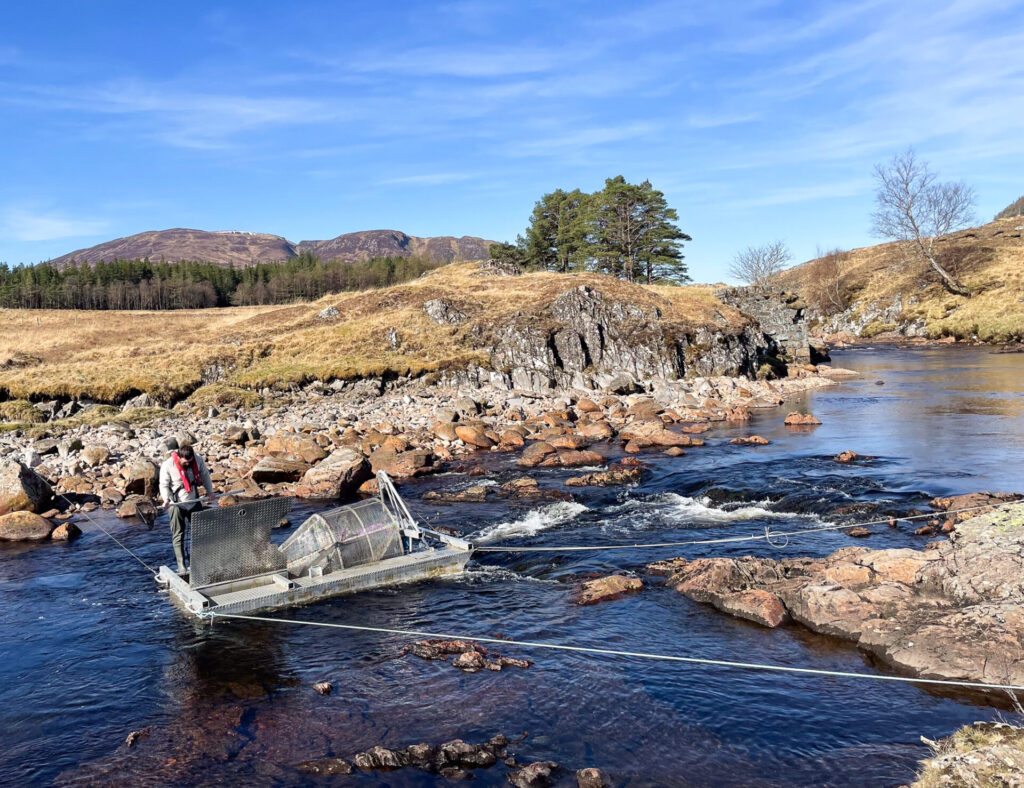
Our Smolt Trap, situated 3 miles above Spey Dam.
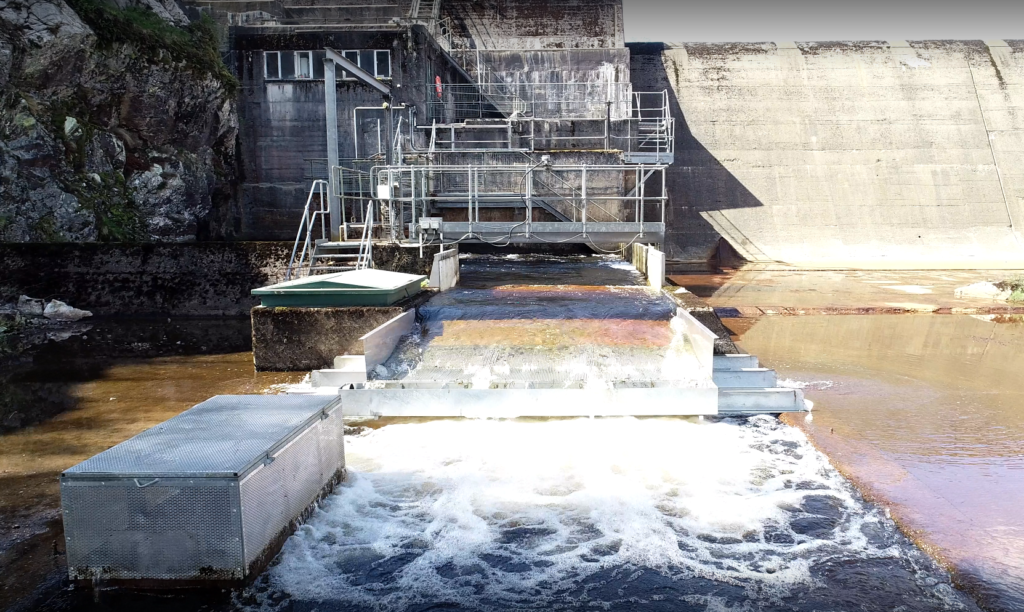
GFF’s Wolf Trap, ready to collect any smolts that pass through the fish pass at Spey Dam.
For two months, Spey Fishery Board Biologists and Bailiffs completed a 150-mile round trip, seven days a week, to visit the smolt trap beside Glenshero Lodge to join ALVANCE and JAHAMA staff and work together to dye–mark smolts before releasing them. These smolts would then continue their downstream migration. Any smolts which successfully travelled through the fish pass at Spey Dam would then be caught in the Wolf Trap. The team then recorded the number of smolts that had completed this migration, including any dye-marked fish, before releasing them to carry on their journey.
“This project will significantly enhance our understanding of smolt migration and survival in the upper River Spey,” said Roger Knight, Director of the Spey Fishery Board. “The data collected will inform our conservation strategies and help us better understand how to increase the number of smolts reaching the sea.“
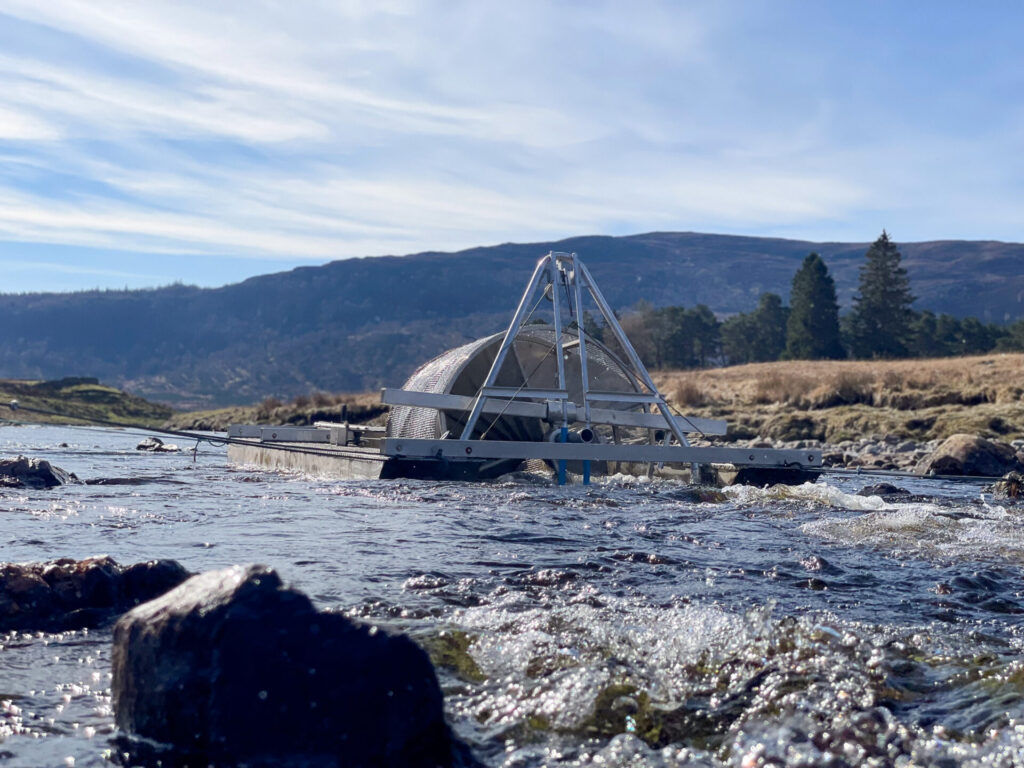
Smolt trap, collecting smolts 24/7.
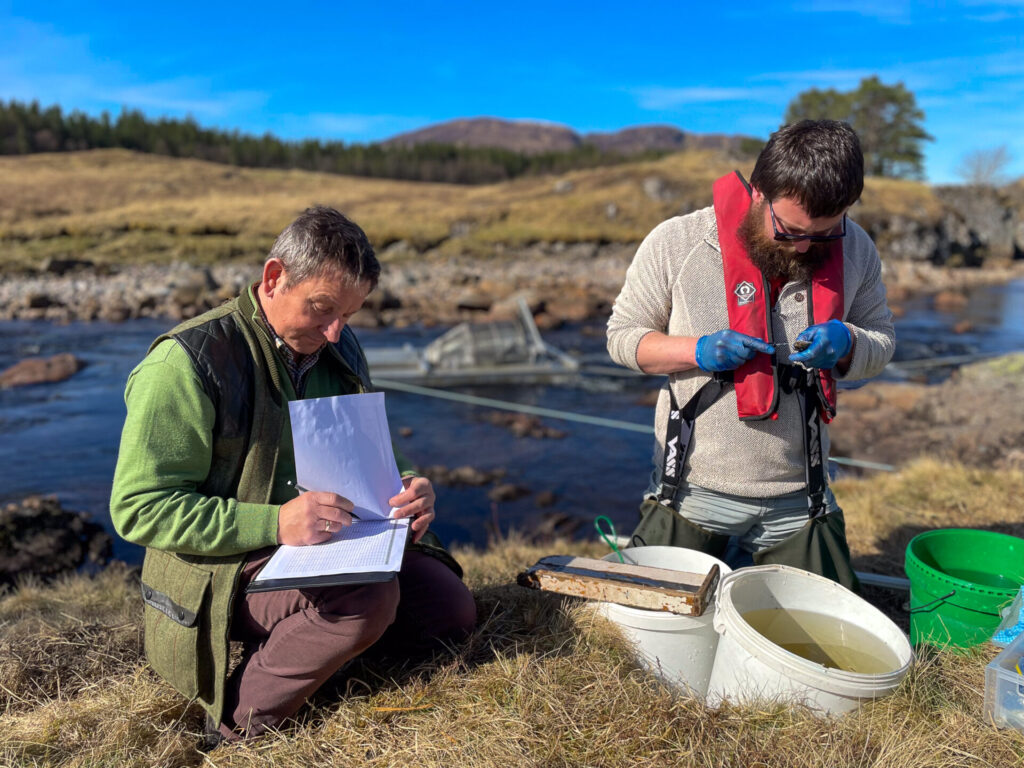
Roger Knight and Atticus Albright dye marking smolts.
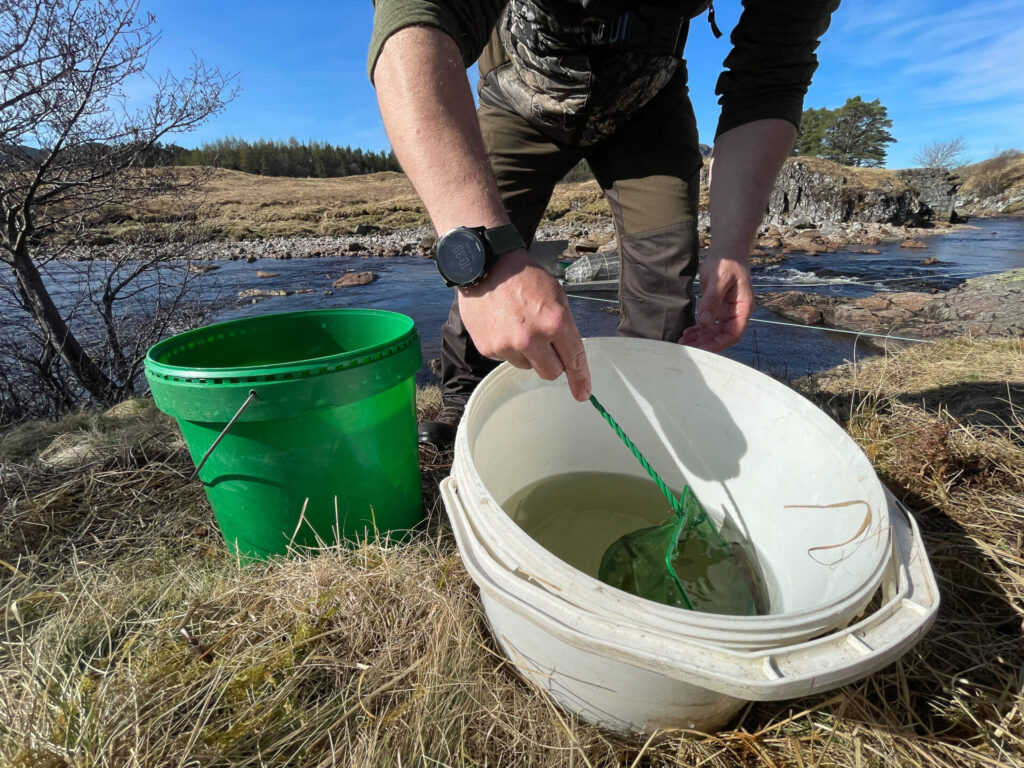
Richard Whyte, preparing to release the dye marked smolts.
Tom Uppington, Managing Director at ALVANCE British Aluminium & JAHAMA Highland Estates, shared: “Our collaboration with the Spey Fishery Board on this important tracking project demonstrates our commitment to promoting sustainable practices and ensuring the survival of our local fish populations.”
Apart from providing and installing the Wolf Trap, ALVANCE & JAHAMA also supported the smolt tracking project by providing staff to assist in trapping, marking, and releasing smolts. “We’re proud to play an active role in these important conservation efforts, which feeds into our wider bio-diversity improvement initiatives on the upper Spey area,” noted Tom Uppington.
The next step in this project is to analyse the data, which will be released in due course. These findings will shed light on the number of smolts migrating through Spey Dam and indicate any challenges they might face.
We are pleased to report that ALVANCE British Aluminium & JAHAMA Highland Estates is continuing work on improvements to the Spey Dam fish pass.
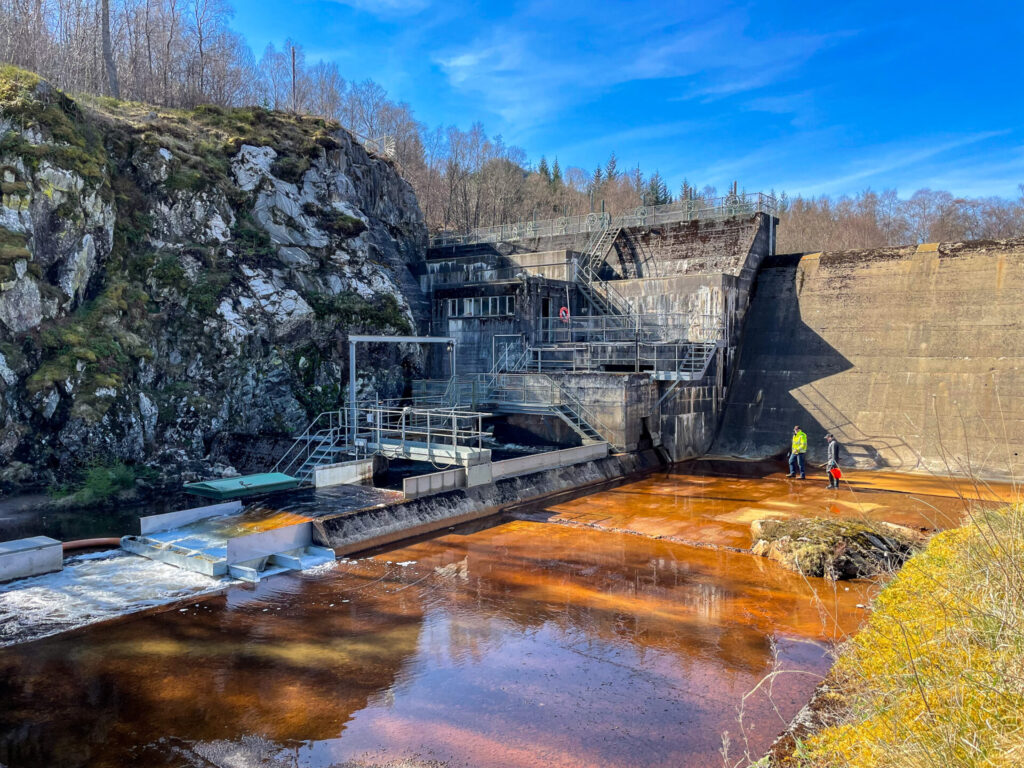
Spey Dam, pictured in May 2023.
A recent innovation saw the installation of LED lighting within the fish pass, linked to an external sensor which mimics the natural, ambient lighting and thereby reducing potential confusion for migrating fish due to stark light contrasts. This solution was developed with design consultants Multiconsult and Fishtek, as well as local electrical contractors Industrial Electrical Services (IES).
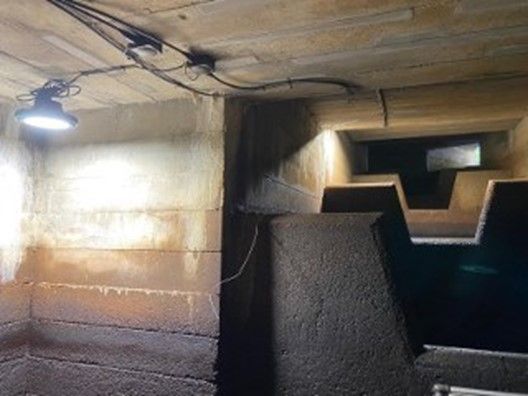
Lighting inside the Spey Dam fish pass.
Furthermore, ALVANCE British Aluminium is spearheading a project to automate the Spey Dam’s fish pass gates. Since the Dam’s construction in the 1940s, these gates have been manually operated and set at 8:30 am daily to regulate water flow through the fish pass. The proposed automation will allow daily adjustments to the fish pass flows, adapting to weather conditions and reservoir inflows. This significant investment will automate the seven most frequently used fish pass gates. Although funding has not yet been confirmed, the Managing Director of GFG at Lochaber strongly supports this and intends to secure internal budget funding.
Follow us on social media to stay connected for more updates on our ongoing Spey Dam projects.
Continue reading...
Spey Dam Smolt Tracking Project
The monitoring project, which began at the end of March, aims to improve our understanding of smolt populations in the Upper Spey and assess the impact of the Spey Dam on downstream smolt migration. We, therefore, installed a smolt trap in the Upper Spey, three miles above Spey Dam. In parallel, GFG Alliance designed and installed a state-of-the-art Wolf Trap below the Spey Dam in the compensation outflow – referred to as the “gold standard of wolf traps” by our Director, Roger Knight.

Our Smolt Trap, situated 3 miles above Spey Dam.

GFF’s Wolf Trap, ready to collect any smolts that pass through the fish pass at Spey Dam.
For two months, Spey Fishery Board Biologists and Bailiffs completed a 150-mile round trip, seven days a week, to visit the smolt trap beside Glenshero Lodge to join ALVANCE and JAHAMA staff and work together to dye–mark smolts before releasing them. These smolts would then continue their downstream migration. Any smolts which successfully travelled through the fish pass at Spey Dam would then be caught in the Wolf Trap. The team then recorded the number of smolts that had completed this migration, including any dye-marked fish, before releasing them to carry on their journey.
“This project will significantly enhance our understanding of smolt migration and survival in the upper River Spey,” said Roger Knight, Director of the Spey Fishery Board. “The data collected will inform our conservation strategies and help us better understand how to increase the number of smolts reaching the sea.“

Smolt trap, collecting smolts 24/7.

Roger Knight and Atticus Albright dye marking smolts.

Richard Whyte, preparing to release the dye marked smolts.
Tom Uppington, Managing Director at ALVANCE British Aluminium & JAHAMA Highland Estates, shared: “Our collaboration with the Spey Fishery Board on this important tracking project demonstrates our commitment to promoting sustainable practices and ensuring the survival of our local fish populations.”
Apart from providing and installing the Wolf Trap, ALVANCE & JAHAMA also supported the smolt tracking project by providing staff to assist in trapping, marking, and releasing smolts. “We’re proud to play an active role in these important conservation efforts, which feeds into our wider bio-diversity improvement initiatives on the upper Spey area,” noted Tom Uppington.
The next step in this project is to analyse the data, which will be released in due course. These findings will shed light on the number of smolts migrating through Spey Dam and indicate any challenges they might face.
Spey Dam Fish Pass Modifications
We are pleased to report that ALVANCE British Aluminium & JAHAMA Highland Estates is continuing work on improvements to the Spey Dam fish pass.

Spey Dam, pictured in May 2023.
A recent innovation saw the installation of LED lighting within the fish pass, linked to an external sensor which mimics the natural, ambient lighting and thereby reducing potential confusion for migrating fish due to stark light contrasts. This solution was developed with design consultants Multiconsult and Fishtek, as well as local electrical contractors Industrial Electrical Services (IES).

Lighting inside the Spey Dam fish pass.
Furthermore, ALVANCE British Aluminium is spearheading a project to automate the Spey Dam’s fish pass gates. Since the Dam’s construction in the 1940s, these gates have been manually operated and set at 8:30 am daily to regulate water flow through the fish pass. The proposed automation will allow daily adjustments to the fish pass flows, adapting to weather conditions and reservoir inflows. This significant investment will automate the seven most frequently used fish pass gates. Although funding has not yet been confirmed, the Managing Director of GFG at Lochaber strongly supports this and intends to secure internal budget funding.
Follow us on social media to stay connected for more updates on our ongoing Spey Dam projects.
Continue reading...
